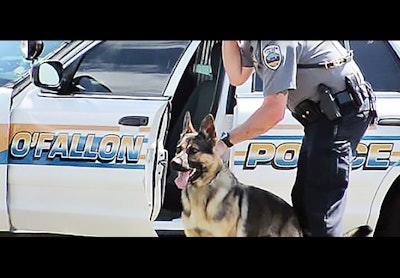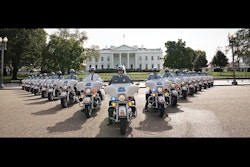 Photo: AceK9
Photo: AceK9
You find yourself in between a police K-9 and the bad guy it's chasing down…what do you do? How about at the end of a physical arrest when you're trying to handcuff the suspect while the K-9 has physical hold of the suspect as well…what do you do? Did you ever think what you will do if the K-9 mistakes you for the bad guy? What do you do?
Officers often come to me with these questions after the fact or at the "too late" stage. We plan, we train, we try to anticipate as many probabilities as we can think of, except we often forget the dog's involvement in a police call. Here are some tips for what to do so you won't find yourself in the way when working with a K-9 on scene.
How We Use K-9s
Police dogs make a very effective search tool when used properly. In the seminal research work of William G. Syrotuck "An Introduction to Land Search Probabilities and Calculations" it's stated that three properly trained police dogs can take the place of 88 trained human searches in a 1-square-mile search and the dogs are significantly more effective than a helicopter in this same area.
The police dog is also a significant protection tool for the public and for officers. In fact the court has noted "…deployment of a K-9 team can prevent the necessity of deadly force." (Robinette v. Barnes). There are countless videos online showing a K-9 deployed successfully preventing law enforcement officers from using deadly force. There are also, unfortunately, too many cases in which dogs have been killed in the line of duty.
Police work is sometimes violent and occasionally things go horribly wrong. Officers enter a call with a well thought-out response plan only to see it turn downwards and unpredictable. The best intentions are sometimes met with fierce resistance from suspects. Sometimes the dog is deployed when it should be, sometimes when it shouldn't, and sometimes both.
Both? Yes, sometimes the dog is initially deployed properly and with sound legal basis only for the circumstances to change in a millisecond, making the dog no longer the best tool. Take, for example, a case in which the dog team is tracking a violent suspect. The team locates the suspect and the bad guy decides to run. The handler determines that K-9 use of force is reasonable and the best and safest option and decides to release the dog to chase down the fleeing felon.
Seconds later, a backup officer appears from the flanking side between the K-9 and the suspect and begins to run after the suspect. Let's now say you are that back-up officer. You find yourself in between the bad guy and the running K-9. It looks like the K-9 is now coming after you! What do you do?
Stay Cool and Calm
First, stay cool and calm. Know that the handler is also reacting to this new set of circumstances and is probably working on recalling the dog or otherwise commanding the dog to avoid you. If you can't reach relative safety in time, you should next STOP moving and face the dog with arms crossed in front of you, protecting your groin area with forearms and hands. Stopping helps to remove the "prey" or chase instincts in the dog and may readjust the focus of the chasing dog back to the moving suspect.
You may also want to calmly reach for your pepper spray or TASER. While the pepper spray will have little effect on the dog, it may have enough to thwart the dog's movement toward you. The TASER is very effective in stopping a dog, but remember to give the verbal announcement for TASER use dictated by your department policy prior to using it. Otherwise, officers involved may misinterpret the pop of the TASER as the sound of a gunshot.
Let's say these tactics fail and you find yourself being bitten by the police dog. Again, stay as calm as you can, knowing that the properly trained and certified dog is trained to apprehend the arm, leg, or buttocks area. These dogs are also trained to apprehend and hold, so while the dog may be biting you, they are taught to hold that same spot until commanded by the handler to release, which I hope is happening at this point.
The bite wound will not usually be severe. Some puncture wounds, bruising, and soreness are the common aftermath of most police dog bites. Most people recover within a few days to a few weeks. It is in apprehensions where the suspect tries to violently fight off the dog that more physical damage results because of the dog adjusting to keep hold or to regain its grip on the suspect.
Listen to the Handler
When working in close quarters with a police dog, it is important to listen to the handler's instructions. This can be difficult if not everyone is on the same page. Calls with many officers on scene can be chaotic when there are multiple officers issuing different commands to the suspect. Hopefully you, your department, and surrounding departments have trained for these types of calls so that there is only one officer issuing commands for the suspect to follow.
Let's say that you have been instructed to handcuff a suspect or otherwise help to control someone who is being actively bitten by the dog. It is important to again stay cool and calm and listen to the handler's instructions. If not told, ask the handler how to approach the suspect, from what direction, and so on. Doing any more or less may jeopardize the K-9's control of the suspect.
Officer Down
If a K-9 handler is injured, you may need to tend to the dog, which can prove difficult, especially if the dog is worried about protecting its handler. But there are steps you can take to ensure the handler and dog receive aid, if needed.
In the event of a vehicle crash, a handler may be unable to remove him- or herself from the cruiser and may need outside help. If the accident is that severe, the dog will probably be unconscious because K-9s are not restrained by seat belts in cruisers like humans and tend to get tossed around during crashes. If this is the case, you will be able to remove the dog from the car to receive medical aid.
If the dog is conscious and interfering aggressively with the removal of the handler from the vehicle, look for a training sleeve in the trunk of the handler's cruiser. Most carry their training equipment with them. If a training sleeve is not available, then take your leather cruiser jacket, a firefighter's leather jacket, or something with some toughness to it and wrap it around your arm, thereby creating a protective bite sleeve. Have another cruiser with a barricaded back seat close by with its back door open.
Allow the dog to "apprehend" your wrapped arm and simply escort the dog as it has hold of the wrapped arm into the back seat of the awaiting cruiser, slipping the protective sleeve off as the dog enters the cruiser. You can then close the door quickly and wait for another handler to help care for the dog.
Get Acclimated
There is no replacement for experience, but training is the next best thing. I always worked with probationary officers or cadets in the Police Academy to acclimate them to the work of the police dog. I didn't want them to see their first K-9 apprehension at a real call, but instead within the control of the training field. It's one thing to read about what to do and how to react, but quite another to experience it firsthand.
I encouraged them to don the protective sleeves and suits and to take an apprehension from the trained dog so they could see up close what it looked and felt like. I wanted to remove the novelty and the spectator aspect of dog use in the training field, so when it came to the real call, they would be better able to keep their heads, remain calm, and listen to the handler. I recommend that every officer do the same.
Keep Learning
There is scenario after scenario that I could write and you could question. Nothing, but nothing, in this piece is designed to take away from your proper training or department policy in regard to K-9-involved calls. This is just some simple advice for some very complicated problems.
I urge you to learn more about your regional K-9 units, to spend a day or two training with them (they are always looking for helpers), and to familiarize yourself with their capabilities and limitations. Please reach out to your handlers and trainers to learn more.
As a last resort, the killing of a police K-9 may be necessary in certain situations. But don't be put into a situation where the only option that comes to mind is to shoot the K-9. There may be another way to avoid the interaction to begin with or there may be a way to avoid being the focus of the dog at the call.
Dr. David J. "Lou" Ferland is a retired chief of police and former K-9 handler and trainer with the Portsmouth (NH) Police Department. He currently serves as the executive director of the United States Police Canine Association and is a nationally certified police K-9 trainer and judge. He can be reached at DavidFerlandK9@gmail.com.









